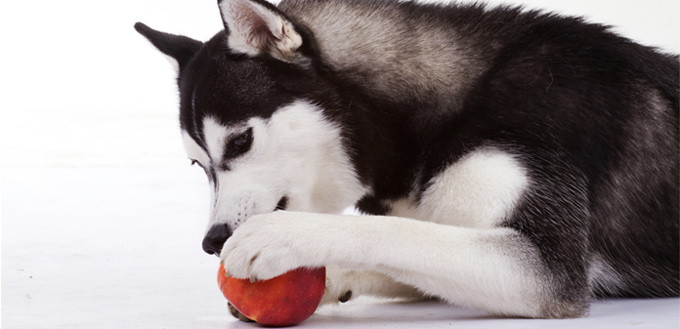One questions owners sometimes ask is can dogs eat mango? Maybe you want to include more nutrients and fiber in your dog’s diet, or perhaps you’d just like to introduce him to some new treats and flavors. You may be looking for something edible that’s more natural and less processed to reward him with when he’s been good.
Processed treats for dogs and other domestic animals have been subject to controversy in recent years. They’re often made with animal byproducts and substances that humans would never eat. Many pet owners are seeking to move towards foods that are more natural and of a quality that we would consume ourselves.

But Aren’t Dogs Carnivores? Why Would They Need to Eat Fruit?
Your dog is by nature and ancestry a carnivore, relying on the fats and proteins in meat for his health and wellbeing. Fruits and vegetables are carbohydrates; and he does not necessarily NEED carbohydrates in his diet. This has been confirmed by research carried out by the Association of American Feed Control Officials, among other bodies, which uses this fact in building its Pet Food Nutrient Profiles.
However, there is evidence to suggest that wolves, the dog’s closest relative in the wild, do occasionally supplement their diets with fruit and other vegetation. While there’s plenty of debate in the veterinary and wider animal world about whether fruits and vegetables are required for canine good health, many experts agree that they are useful, albeit not essential, supplements to a dog’s diet.
Also, mangoes and other fruits have a sweet flavor that many dogs love. Provided they do your dog no harm, they may be an attractive alternative to processed dog treats and can actually do them some good.
What Are the Benefits of Mangoes?
Mangoes are high in fiber and calcium. Additionally, they contain other nutrients such as vitamins A, B6, C and E. While obviously mango should never make up the bulk of your dog’s diet, these vitamins and other nutrients can play an important role in your dog’s health and well-being.
Fiber – essential to prevent diarrhoea and constipation; helps your dog feel fuller for longer, thereby discouraging overeating and weight gain; assists in the production of fatty acids which help discourage harmful bacteria in your dog’s gut.
Calcium – for healthy bones, teeth, muscles and nervous system. Also vital to pregnant dogs who are prone to eclampsia if calcium-deficient.
You May Also Like: Calcium Supplements for Dogs
Vitamin A – for a shiny coat, healthy skin, good eyesight and healthy growth in young dogs.
Vitamin B6 – for strong immune and nervous systems, healthy brain processes and the manufacture of red blood cells.
Vitamin C – contributes towards a sound immune system and the development of skin, teeth, bones and cartilage.
Vitamin E – an antioxidant that helps prevent the formation of harmful free radicals, and promotes immunity, brain function and good eyesight.
Related Post: Vitamins for Pregnant Dogs
How Should I Incorporate Any New Food Into My Dog’s Diet?
Whenever you plan to introduce a new food into your dog’s diet, you should first check out online or with your vet whether he is allowed to have it.
Some foods that are quite safe for humans can contain substances that are toxic to dogs. Chocolate, for instance, contains theobromine, a compound derived from cacao seeds. While humans can easily metabolize this, dogs cannot, and it can build up to toxic levels in their systems.

In terms of fruit and veg, there are some that your dog can happily eat and digest and others that can cause anything from mild stomach upset and diarrhea to other, more serious health conditions. Avocado, for example, contains persin, a toxin that can result in vomiting and diarrhea in dogs. Grapes and raisins can cause sudden, acute kidney failure in canines. So it’s always essential to research any new food before you include it in your dog’s diet.
Once you’ve determined the foodstuff is safe for dogs generally, you should consider whether it’s ok for your own pet specifically. Does he have any existing allergies or intolerances to specific foods? Your vet’s advice is useful here.
After your dog has eaten any new food, monitor him over the following few days for signs of stomach upset, diarrhea, or vomiting. He might have an intolerance to specific fruits.
So How Should I Prepare and Introduce Mango Into My Dog’s Diet?
- Carefully wash the fruit to remove dirt, grime, and any bacteria from the skin’s surface.
- Peel and cut the flesh into chunks if necessary. Larger dogs will have no difficulty coping with large chunks, especially if the mango is ripe, as it’s a soft, juicy fruit. But if you own a small breed, consider chopping it up for him – the smaller your dog, the smaller the portion you should give him.
- It’s ok for him to eat the skin, but he may find it difficult to digest. For preference, remove it entirely.
- Feed him one small portion first to see if he’s attracted to the fruit. As above, wait a while to see if he has any adverse reaction before feeding mango to him again.
- Mangos have large stones at their center. Remove this pit completely and dispose of it safely, out of his reach. If swallowed, these could cause an obstruction in the gut or intestines.
- Mango pits also contain tiny amounts of cyanide, so it’s not a good idea for him to chew or swallow them for that reason either.
What If I Think My Dog Has Swallowed a Mango Pit?
If you see any of the following symptoms, whatever you suspect your dog has swallowed, seek veterinary advice as a matter of urgency:
- Choking
- Diarrhea, vomiting – or both;
- A decreased appetite;
- An abdomen that appears to be sensitive to the touch;
- Listlessness or lethargy; and/ or
- Dehydration
If your dog is displaying no symptoms, but you’re fairly sure he’s swallowed a stone from a mango, you should pay a trip to your vet anyway as a precaution. It’s entirely possible the pit could pass harmlessly through his digestive system, but better to be safe than sorry.
How Much Mango Can My Dog Eat In One Sitting?
Use your discretion, based on your dog’s size and appetite. But do note that canines’ digestive systems are not built to cope with large quantities of fiber. Feed him too much in one go and you’re more likely to face a bout of diarrhea or a stomach ache. As with all things in life, for dogs as well as humans, moderation is the key!
Sources:
- Pet Nutrient Profiles – Association of American Feed Control Officials
- Katherine Ripley, Can Dogs Eat Mango?, The American Kennel Club
- Emily Cardiff, 5 Fruits and Veggies That are Toxic to Your Dog, One Green Planet







